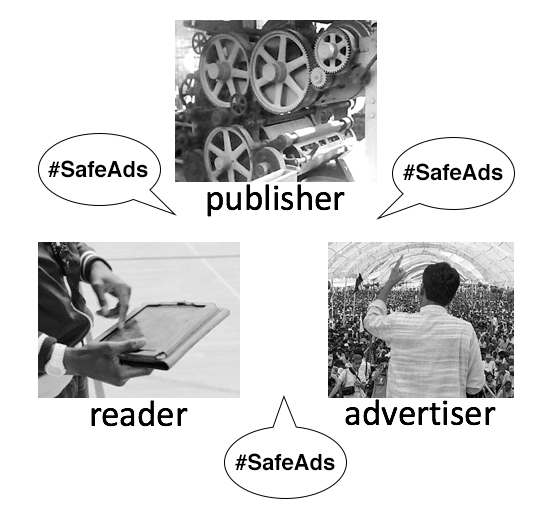
The GDPR (General Data Protection Regulation) is the world’s most heavily weaponized law protecting personal privacy. It is aimed at companies that track people without asking, and its ordnance includes fines of up to 4% of worldwide revenues over the prior year.
The law’s purpose is to blow away the (mostly US-based) surveillance economy, especially tracking-based “adtech,” which supports most commercial publishing online.
The deadline for compliance is 25 May 2018, just a couple hundred days from now.
There is no shortage of compliance advice online, much of it coming from the same suppliers that talked companies into harvesting lots of the “big data” that security guru Bruce Schneier calls a toxic asset. (Go to https://www.google.com/search?q=GDPR and see whose ads come up.)
There is, however, an easy and 100% GDPR-compliant way for publishers to continue running ads and for companies to continue advertising. All the publisher needs to do is agree with this request from readers:

That request, along with its legal and machine-readable expressions, will live here:

The agreements themselves can be recorded anywhere.
There is not an easier way for publishers and advertisers to avoid getting fined by the EU for violating the GDPR. Agreeing to exactly what readers request puts both in full compliance.
Some added PR for advertisers is running what I suggest they call #Safeds. If markets are conversations (as marketers have been yakking about since The Cluetrain Manifesto), #SafeAds will be a great GDPR conversation for everyone to have:

Here are some #SafeAds benefits that will make great talking points, especially for publishers and advertisers:
- Unlike adtech, which tracks eyeballs off a publisher’s site and then shoot ads at those eyeballs anywhere they can be found (including the Web’s cheapest and shittiest sites), #SafeAds actually sponsor the publisher. They say “we value this publication and the readers it brings to us.”
- Unlike adtech, #SafeAds carry no operational overhead for the publisher and no cognitive overhead for readers—because there are no worries for either party about where an ad comes from or what it’s doing behind the scenes. There’s nothing tricky about it.
- Unlike adtech, #SafeAds carry no fraud or malware, because they can’t. They go straight from the publisher or its agency to the publication, avoiding the corrupt four-dimensional shell game adtech has become.
- #SafeAds carry full-power creative and economic signals, which adtech can’t do at all, for the reasons just listed. It’s no coincidence that nearly every major brand you can name was made by #SafeAds, while adtech has not produced a single one. In fact adtech has an ugly history of hurting brands by annoying people with advertising that is unwelcome, icky, or both.
- Perhaps best of all for publishers, advertisers will pay more for #SafeAds, because those ads are worth more.
#NoStalking and #SafeAds can also benefit social media platforms now in a world of wonder and hurt (example: this Zuckerberg hostage video). The easiest thing for them to do is go freemium, with little or no ads (and only safe ones on the paid side, and nothing but #SafeAds on the free side, in obedience to #NoStalking requests, whether expressed or not.
If you’re a publisher, an advertiser, a developer, an exile from the adtech world, or anybody else who wants to help out, talk to us. That deadline is a hard one, and it’s coming fast.

